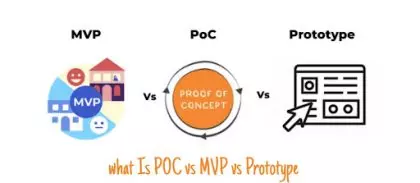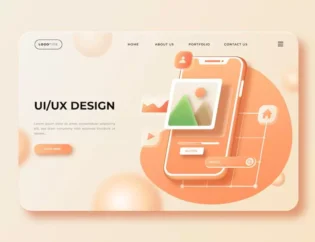
Excerpt: Often there are three methods employed while building a mobile app- POC vs Prototype vs MVP. For anyone who is new to this mobile app building or doesn’t know about it, might find it difficult to choose one. Hence we have a detailed description of each one of them with their respective benefits.
Read Time: 7 mins
Mobile Application
POC vs Prototype vs MVP: Many businesses are often unsure if a proof of concept (POC), prototype, minimum viable product (MVP), or a combination of the three is the best method to go about developing a mobile app. Understanding and properly implementing these three techniques of mobile product validation will greatly enhance your prospects of gaining investor buy-in and obtaining funding, as well as lowering project expenses and ensuring long-term viability in the mobile app market.

POC vs Prototype vs MVP: Understanding what you’re building is the first step in developing a mobile app. By testing assumptions, disclosing user needs, and outlining a specific direction for product growth, all three approaches of product validation position a mobile app for success. You may be sure that the proposal you present to investors and stakeholders is a strong business case with multiple clear returns on investment (ROI) chances if you use a good validation process.
Quick Reads
Proof of Concepts (P.O.C)
Approach: Is the idea feasible?
Implementation: The quickest and most precise way to validate or invalidate assumptions about your target audience and app concept is to create a proof of concept.
Mobile App Prototype

Approach: How will the product function?
Implementation: Mobile app prototype is a type of user research used to confirm a product’s strategic design direction. A prototype is a rough representation of a functioning product. Prototypes help test how customers utilize and react to the overall user experience (UX) design. Using a prototype for usability testing allows you to make improvements to important design issues before the product reaches development, when it’s too late (and too expensive) to make big UX modifications.
Minimum Viable Product (MVP)

Approach: What are the product’s main features and its value proposition?
Implementation: A mobile application MVP stands for Minimum Viable Product, which is a stripped-down and usable version of your full product that you may test and distribute on the app store. Your team will be able to discover how the product’s target users interact with and respond to the app’s key business purpose using the MVP development technique. You can direct your time, effort, and cash to areas that best meet your overall business objectives by using the insights and learnings from real users. Building an MVP is an iterative process for identifying user demands and determining the appropriate functionality to meet those needs over time.
Now let’s dig deeper into these aspects of developing a mobile app.
What is a POC?
A mobile application A proof-of-concept (POC) is a short internal validation project. The proof-of-concept method of product validation focuses on proving functionality and determining whether a certain concept is possible to develop. Using a POC is also a great way to share inside knowledge about a product’s basic functionality. Usability and UX decisions are not taken into account for a POC because mapping our UX is time-consuming, and UX design can interfere with proving viability.
“A proof of concept (POC) will provide you with a decisive “yes” or “no” answer; either the concept is viable or it isn’t.”
Even if a POC demonstrates that the concept isn’t viable, alternative options can be developed from the same starting point.
Creating a POC is especially vital if the concept does not yet exist in the app market or if you want to set yourself apart from competitors. Developing an app in a crowded market does not necessitate proof that the concept is viable, the product must include a distinctive feature set to differentiate itself from comparable concepts, which necessitates a POC.
What is a Mobile App Prototype?

A mobile app prototype, unlike a POC, depicts how a product concept will be implemented. Prototyping can take many forms, but in the case of mobile app development, it usually begins with sketches or a paper interface and progresses to an interactive model that resembles the final result. A prototype’s goal is to describe a product’s design and navigation flow so that development can be as efficient as possible. Prototyping is a useful exercise that allows you to see how your app will work by showcasing user flows and displaying a working design and layout. A prototype, of course, will contain faults, but one of the aims of a prototype is to uncover these errors early in the project’s development.
For user-centric design and development, testing a mobile product with a prototype is critical. Prototyping is an important aspect of the design thinking research process because it allows for rapid iteration and the creation of a product that provides the most value to the consumer. Prototyping can frequently reveal new ideas and establish the best development path. This process allows making adjustments less costly.
If you want to dive deeper into mobile prototyping, click here
What Is A Minimum Viable Product?

Prototypes frequently impact MVPs, and the two collaborate to develop a successful final product. An MVP is a stripped-down version of your full product that is tested in the market. This kind of development lets you see how your people will react to your product before investing a lot of time and money into something that no one wants or needs. While prototypes tackle problems early in the development process, an MVP’s iterative method is designed to identify users’ pain points once the product is evaluated in the market.
Validating your product assumptions with an MVP is critical to avoid producing more (or less) than you need. Starting with a basic feature, learning how customers react to it, and then expanding based on user input is critical for finding the right amount of functionality your product requires to attract and retain consumers. The lessons learned from an MVP define your product roadmap and steer the progress of your software over time.
MVP is a version of a product that has only the features it needs to be marketable. You can confirm the following using the MVP process:
- Product viability
- Product assumptions
- Usability
- Market demand
MVPs deliver quick value at a low cost of development. Finally, an MVP lets you start with a basic product and iteratively add features to generate a better one. The product grows with each release version to maximize ROI and progress toward a fully developed application.
Benefits of MVP
An MVP delivers instant value while reducing development costs and revealing the best path for future development.
What constitutes an MVP can be highly subjective, varying from company to company depending on business goals, industry, and competitors. Choosing an iterative, agile method versus an all-or-nothing approach to app development has significant advantages.
- A Core Set Of Functionalities To Test Business Concepts Early On
An MVP helps you to test your business concept by bringing a version of your product to market early. You may test important hypotheses, acquire user knowledge and intelligence, go to market rapidly, and keep costs down by offering a core set of functions rather than a full-fledged, feature-heavy product.
- Cost- Efficiency
As previously stated, mature products are the result of years of research and development, and they come with a price tag to match. However, because these apps were developed iteratively over a longer period of time, the expense is spread out across time, with revenue from previous versions being reinvested.
- Iterative Process Drives Product Evolution
Because an MVP requires you to go to market with only the most basic features and functions, you may start creating a user base to learn what works and what doesn’t. This is critical information since it helps product teams to use data to make judgments about future product iterations, such as what further features to include, what aspects would enhance sales, and where to allocate funding.
Which One Is Better POC vs Prototype vs MVP?
These three methods are quick and inexpensive ways to validate a mobile app idea, but they also have a number of other advantages, such as eliciting new ideas and areas for improvement, involving clients and stakeholders, and ensuring that everyone on the team is on the same page throughout the project lifecycle. Using one or all of these strategies will help you avoid common product blunders, such as incorrect features or a product that has no place in the market at all, if you want to improve your product launch and boost the likelihood of success. When utilized correctly, each strategy has its own set of benefits, whether it’s for early testing of key business concepts, winning over stakeholders, or proving marketability.
May you also like: How To Create an App Prototype
May you also like: Why App Development is Expensive ?
May you also like: Top 5 things A Software Company Must Do For customer
TagsApplication Prototyping, Mobile App Building, mobile application, MVP, POC










